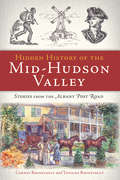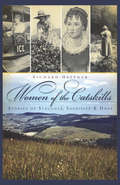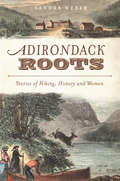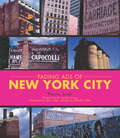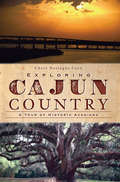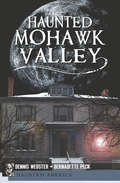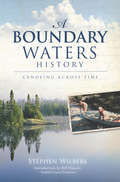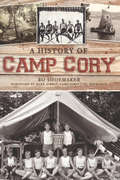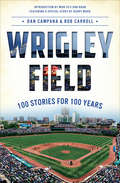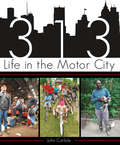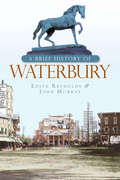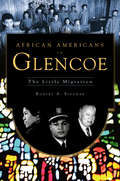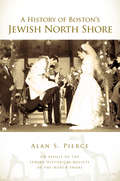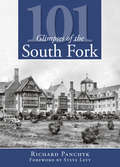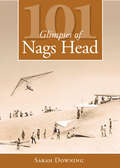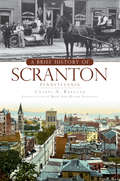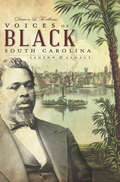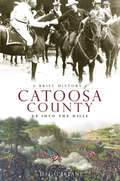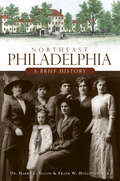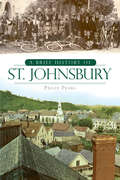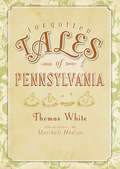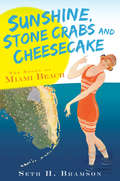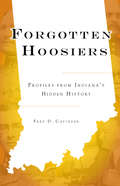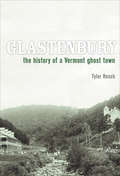- Table View
- List View
Hidden History of the Mid-Hudson Valley: Stories from the Albany Post Road (Hidden History)
by Tatiana Rhinevault Carney RhinevaultThe Albany Post Road was the vital artery between New York City and the state capital in Albany in the eighteenth and nineteenth centuries. It saw a host of interesting events and colorful characters, though these unusual and extraordinary stories, as well as their connection to the thoroughfare, are oft forgotten. Revolutionary War spies marched this path, and anti-rent wars rocked Columbia County. Underground Railroad safe houses in nearby towns like Rhinebeck and Fishkill sheltered slaves seeking freedom in Canada, and Frank Teal's Dutchess County murder remains unsolved. With illustrations by Tatiana Rhinevault, local historian Carney Rhinevault presents these and other hidden stories from the Albany Post Road in New York's mid-Hudson Valley.
Women of the Catskills: Stories of Struggle, Sacrifice & Hope (American Chronicles)
by Richard HeppnerHailing from the home of industrious, strong and creative individuals, the women of the Catskills have embodied this rugged spirit best. Though often overlooked in Catskill Mountain history, their stories are inspiring, like that of Candace Wheeler, who used her rural upbringing to achieve personal success and improve life for others. They are personal, such as Lucy Lobdell's story. A century ahead of her time, she challenged conventional thoughts on equality and lifestyle. Most of all, they reflect the spirit of their surroundings, as independent women like Marion Bullard challenged the status quo to build a better community. Overcoming the physical challenges of mountain life and the societal obstacles they faced because of their gender, Catskills' most fearless women are revealed by local historian Richard Heppner.
Adirondack Roots: Stories of Hiking, History and Women (American Chronicles)
by Sandra WeberThe Adirondack Mountains captivate inhabitants, fostering deep roots and rich memories. In this diverse collection, local author Sandra Weber celebrates this enduring bond with the region and explores its roots and routes--such as women's feats, the naming of mountain peaks and the fight to save forests and tiny alpine plants. From Heart Lake and Caribou Pass to Mount Marcy and Lake Tear, ride an Olympic bobsled run, unearth the destruction of a devastating fire and discover the healing powers of the mountains. Retrace the paths of Theodore Roosevelt, Martha Reben, Edwin Ketchledge, Grace Hudowalski and many others who have lived in and loved the Adirondacks. Unearth hikers' tales, nature's secrets and local legends in this collection of Weber's finest reflections on Adirondack historical adventures.
Fading Ads of New York City (Fading Ads)
by Wm. Stage Frank Jump Dr Andrew Irving Kathleen HulserNew York City is eternally evolving. From its iconic skyline to its side alleys, the new is perpetually being built on the debris of the past. But a movement to preserve the city's vanishing landscapes has emerged. For nearly twenty years, Frank Jump has been documenting the fading ads that are visible, but less often seen, all over New York. Disappearing from the sides of buildings or hidden by new construction, these signs are remnants of lost eras of New York's life. They weave together the city's unique history, culture, environment and society and tell the stories of the businesses, places and people whose lives transpired among them -- the story of New York itself. This photo-documentary is also a study of time and space, of mortality and living, as Jump's campaign to capture the ads mirrors his own struggle with HIV. Experience the ads -- shot with vintage Kodachrome film -- and the meaning they carry through acclaimed photographer and urban documentarian Frank Jump's lens.
Exploring Cajun Country: A Tour of Historic Acadiana (History & Guide)
by Cheré CoenLouisiana's famous Cajun Country is a place where today's travelers can still experience the rich heritage and traditions that began in the eighteenth century. From foodways and folktales to music and festivals, Acadiana offers something you can't get anywhere else. Journey through this historic and unique part of the state with travel writer and historian Cher Coen as your guide Experience Cajun Country through its exceptional cuisine, area events, and historic attractions.
Haunted Mohawk Valley: Mohawk Valley Ghosts And Other Historic Haunts (Haunted America)
by Dennis Webster Bernadette PeckHead toward central and upstate New York and discover this region&’s ghostly history . . . photos included! The Mohawk River winds through upstate and central New York, and along its meandering path residents and visitors have encountered the supernatural. In Utica, ghosts grace the stage of the Stanley Theater. Spirits of Revolutionary War soldiers still march on the Oriskany Battlefield and linger in Schoharie&’s Old Stone Fort. And some former residents of Beardslee Castle in St. Johnsville, Boonville&’s Hulbert House, and the Seashell Inn of Sylvan Beach have resisted vacating. Here, authors Dennis Webster and Bernadette Peck, along with the other members of Ghost Seekers of Central New York, uncover the mysteries behind these and many other haunted places of the Mohawk Valley.
A Boundary Waters History: Canoeing Across Time (Sports History Ser.)
by Stephen Wilbers Bill HansenTeasing out the history of a place celebrated for timelessness--where countless paddle strokes have disappeared into clear waters--requires a sure and attentive hand. Stephen Wilbers's account reaches back to the glaciers that first carved out the Boundary Waters and to the original inhabitants, as well as to generations of wilderness explorers, both past and present. He does so without losing the personal relationship built through a lifetime of pilgrimages (anchored by almost three decades of trips with his father). This story captures the untold broader narrative of the region, as well as a thousand different details sure to be recognized by fellow pilgrims, like the grinding rhythm of a long portage or the loon call that slips into that last moment before sleep.
A History of Camp Cory
by Mark Dibble Bo ShoemakerSummertime memories of Camp Cory are awash in warm emotion. From the Reveille bugle at first light to Taps in the evening, those days were the absolute best. Skippering a K-boat on cool Keuka Lake. Silly songs and skits performed into the night. The boundless nature of genuine friendship. It is hard to explain exactly why that time is so special, how it changes lives forever. This wonderful mystery is revealed here by official Camp Cory historian Bo Shoemaker. So gather around the campfire to reminisce. Just be sure to watch out for the H Man!
Wrigley Field: 100 Stories for 100 Years (Sports Ser.)
by Dan Campana Rob CarrollA collection of stories, photos, and memories for those who love the Chicago Cubs&’ legendary ballpark. Wrigley Field occupies a sacred space in the hearts of Cubs fans and in the soul of Wrigleyville. With contributions from those in the stands, on the field, and behind the scenes over the years—among them Bob Costas, Rick Sutcliffe, Ferguson Jenkins, Steve Stone, and many more—this informal oral history salutes the legacy that has made Wrigley such an unforgettable part of baseball and Chicago for the last century. These one hundred stories reflect the variety of millions of Cubs fans around the world, from those whose relationship with the Friendly Confines has lasted a lifetime to those who are taking their seats up close to the ivy for the very first time.
313: Life in the Motor City
by John CarlisleSince 2007, John Carlisle has fascinated readers with his untold stories of Detroit in his "Detroitblogger John" column for the Metro Times. His words and photographs shed light on the overlooked and forgotten while bringing life to neglected, far-flung neighborhoods. The Detroit chapter of the Society of Professional Journalists named Carlisle the 2011 Journalist of the Year for his work on the city. This collection features dozens of his previously unpublished photographs and forty-two of his most unforgettable stories, including a man who has a strip club in his living room, a bar in a ghost town, a coffee shop for the city's homeless, an art gallery in a mattress store and an old-fashioned debutante ball in the unlikeliest of places.
Lost Detroit: Stories Behind the Motor City's Majestic Ruins (Lost Ser.)
by Dan AustinStories and photographs celebrating the city&’s history through its abandoned architectural landmarks. Lost Detroit tells the stories behind twelve of the city&’s most beautiful left-behind landmarks and of the people who occupied them, from the day they opened to the day they closed. While these buildings might stand as ghosts of the past today, their stories live on within these pages. This book brings you the memories of those who caught trains out of the majestic Michigan Central Station, necked with girlfriends in the balcony of the palatial Michigan Theatre, danced the night away at the Vanity Ballroom, and kicked out the jams at the Grande Ballroom. Filled with stunning and often moving photographs, it&’s a treasure for history and architecture buffs, as well as for native Detroiters. &“A fascinating journey.&” —John Gallagher, Detroit Free Press architecture critic, from the Foreword
A Brief History of Waterbury
by John Murray Edith ReynoldsIn 1681, just twenty-eight humble log cabins built around a marshy green made up what is today Waterbury, Connecticut. The town flourished, and by 1850, its brass- and button-making industries welcomed the Industrial Revolution. When the call came for the Civil War and World Wars I and II, Waterbury gave generously: buttons, to adorn United States military uniforms; and young soldiers, to fight for freedom and become heroes. A Brief History of Waterbury details the ebb and flow of this Connecticut town, the climb to its height, the struggles through adversity and scandal and the glory of modern-day triumphs. In this endlessly intriguing account, authors Edith Reynolds and John Murray uncover the true reaches of Waterbury's dynamic spirit.
African Americans in Glencoe: The Little Migration (American Heritage)
by Robert A. SidemanThe village of Glencoe has a proud history of early African American settlement. In recent years, however, this once thriving African American community has begunto disperse. Robert Sideman, a thirty-year Glencoe resident, relates this North Shore suburb's African American history through fond remembrances of Glencoe communitiessuch as the St. Paul AME Church, as well as recounting the lives of prominent African Americans. At the same time, Sideman poses a difficult question: how can the village maintainits diverse heritage throughout changing times? African Americans in Glencoe reveals an uplifting history while challenging residents to embrace a past in danger of being lost.
A History of Boston's Jewish North Shore (American Heritage)
by Alan S. Pierce Jewish Historical Society of the North ShoreForced to flee the brutal pogroms of Europe, Jewish immigrants sought refuge in the beauty of Boston's North Shore. Drawing on their artisan skills, many found work in the tanneries of Peabody and the shoe factories of Lynn, while other enterprising Jews established their own businesses in Salem and Beverly- from butcher shops and groceries to newspapers. Alongside fellow members of the Jewish Historical Society of the North Shore, Alan Pierce has carefully assembled a collection of personal histories from generations of Jewish families. Celebrating the rich flavors of Jewish culture, these accounts capture familiar faces, such as renowned athlete Herb Brenner, and recognizable landmarks like the Kernwood Country Club and the Dolphin Yacht Club, innovative establishments open to all regardless of race or religion. With entrepreneurial spirit, a little determination and plenty of faith, the North Shore's storied Jewish communities have etched enduring marks on its streets and in its synagogues.
101 Glimpses of the South Fork
by Steve Levy Richard PanchykLong Island's South Fork--famous for the Hamptons--is now one of the hottest summer destinations for the wealthiest and most famous Americans. But it wasn't always so....When European explorers arrived on Long Island's southeastern-most shores in the seventeenth century, they shared the land with the Montauket and Shinnecock Indians. The South Fork remained relatively rural until the railroad arrived in the 1870s. In this pictorial history, Richard Panchyk surveys how dramatically the landscape has changed, from the famous Montauk Lighthouse and iconic windmills to the sprawling mansions and opulent hotels, and highlights some of the notable figures who graced these shores, including New York politicians and a plethora of artists and celebrities. Showcasing the South Fork's famous faces and places, Panchyk reveals this coastal community's bygone era.
101 Glimpses of Nags Head
by Sarah DowningNags Head boasts a plethora of natural wonders. From an ecologically unique maritime forest to breathtaking coastal dunes, the dynamics of the area corroborate the sentiment Thomas Nixon expressed in his 1964 classic. Indeed, as early as the 1830s, merchants and planters from the Albemarle region of North Carolina and Southside Virginia brought their families to Nags Head via boat to exchange the oppressive inland summer heat for cool ocean breezes. In this striking photographic collection, Downing illustrates why this scenic spot on the Outer Banks has been beloved for generations by sun-seekers, sightseers and surfers alike.
A Brief History of Scranton, Pennsylvania (Brief History)
by Cheryl A. KashubaThe intense heat of the steel mills and the clatter of coal-filledlocomotives once filled the streets of Scranton, Pennsylvania. Hardworking immigrants, iron rails, and anthracite coal from beneath the surface of the lush Lackawanna River Valley poweredAmerica's Industrial Revolution, and until World War II, the city reigned as a cutting-edge boomtown. Local journalist Cheryl A. Kashuba chronicles the history of Scranton from the glory days of the Lackawanna Iron and Coal Company and the Dickson Works through the post-Industrial decline and an eventual revitalization of the city. With a deft hand, Kashuba captures the spirit of a proud community and creates a fascinating portrait of the Electric City.
Voices of Black South Carolina: Legend & Legacy (American Heritage)
by Damon L. FordhamDid you know that eighty-eight years before Rosa Parks's historic protest, a courageous black woman in Charleston kept her seat on a segregated streetcar? What about Robert Smalls, who steered a Confederate warship into Union waters, freeing himself and some of his family, and later served in the South Carolinastate legislature? In this inspiring collection, historian Damon L. Fordham relates story after story of notable black South Carolinians, many of whose contributions to the state's history have not been brought to light until now. From the letters of black soldiers during the Civil War to the impassioned pleas by students of "Munro's School" for their right to an education, these are the voices of protest and dissent, the voices of hope and encouragement and the voices of progress.
A Brief History of Catoosa County: Up Into the Hills (Brief History)
by Jeff O'BryantCatoosa County's rich history touches upon many of thedefining events and social changes of America's past. As settlers expanded westward, Georgia forcibly removed Native Americans from the boundaries of what would eventually form Catoosa, a Cherokee name that the settlers adopted as their own. As the site of the second most costly battle in the Civil War, Chickamauga set the stage for much that followedin Catoosa's history, from the end of a three-thousand-year-old mode of warfare to the beginnings of women's service in the military. Though nearly one million people visit Chickamauga and Chattanooga National Military Park each year seeking to understand and connect to the Civil War struggle, many remain unaware of the larger part Catoosa played in the unfolding drama of America. Join local historian Jeff O'Bryant as he brings this valuable heritage to light.
Northeast Philadelphia: A Brief History (Brief History)
by Dr Harry Silcox Frank W. HollingsworthBefore the Consolidation Act of 1854 more than tripled the former capital's population, Northeast Philadelphia was a scattered group of pastoral communities just beyond the city limits. Holmesburg, Somerton and other small villages initially struggled but ultimately triumphed in their transition from rural townships to a bustling urban center. Dr. Harry C. Silcox has collaborated with Frank W. Hollingsworth to chart this fascinating evolution, from the demise of the family farm to neighbors uniting on the homefront during World War II. With such lively characters as Mary Disston, the founding mother of Tacony, and tales of the local effort for suffrage, Silcox and Hollingsworth create a brilliant and affectionate portrait of Northeast Philadelphia.
A Brief History of St. Johnsbury
by Peggy PearlTucked away in the dark forests of Vermont's NortheastKingdom, St. Johnsbury was mostly unbroken wildernesswhen first chartered in 1786. Swinging axes soon made wayfor the burgeoning split-level town, with stately Main Streethomes on St. Johnsbury Plain presiding in grandeur over thebustling commerce of Railroad Street below. Peggy Pearl bringsa decidedly human element to this comprehensive history,wandering the graves of Mount Pleasant Cemetery and bringingto life the stories of those tanners, cobblers, millworkers andbrick makers who made St. Johnsbury their home. With excerpts from vintage newspapers like the Caledonian-Record and the Farmer's Herald, Pearl unfolds the transformation from quiet mill town into picturesque manufacturing hub of Caledonia County.
Forgotten Tales of Pennsylvania (Forgotten Tales)
by Thomas White Marshall HudsonWilliam Penn, the might of Pittsburgh steel and the Revolutionary figures of Philadelphia dominate the scene of Pennsylvania history. Thomas White brings together a collection of tales that have been cast in the shadows by these giants of the Keystone State. From the 1869 storm that pelted Chester County with snails to the bloody end of the Cooley gang, White selects events with an eye for the humorous and strange. Mostly true accounts of cannibalistic feasts, goat-rescuing lawmen, heroic goldfish, the funeral of a gypsy queen and a Pittsburgh canine whose obituary was featured in the New York Times all leap from the lost pages of history.
Sunshine, Stone Crabs and Cheesecake: The Story of Miami Beach
by Seth H. BramsonMiami Beach is unrivaled in the annals of American resort history, and nobody in the country can tell its story better than renowned local historian and resident of Miami for more than six decades Seth H. Bramson. From the 1870 arrival of the Lums on an inhospitable mangrove sandbar to a modern-day hospitality mecca, enjoy this beachfront view of the people and places, booms and busts, reinventions and rebirths of one of the greatest resort cities on earth. Featuring nearly two hundred stunning images drawn mostly from previously unpublished private collections, this is truly a one-of-a-kind trip to Miami Beach.
Forgotten Hoosiers: Profiles from Indiana's Hidden History
by Fred D. CavinderVowing to overcome the sin of seriousness, Indiana-born humorist Don Herold lived up to his promise. Gifted with a droll sense of humor and a vivid imagination, he was one of the most widely read, if least remembered, Hoosiers. In Forgotten Hoosiers, journalist Fred D. Cavinder presents a collection of biographical sketches charting the lives of noteworthy Hoosiers who have been overlooked, as well as acclaimed figures whose Hoosier origins have been obscured. From Harland David Sanders, the pioneering Kentucky colonel who developed the world-famous chicken franchise, to Samuel G. Woodfill, whom many have called the greatest hero of World War I, Hoosiers- both known and unknown- have continued to make their marks across the country and the world.
Glastenbury: The History of a Vermont Ghost Town (Brief History Ser.)
by Tyler ReschThe curious history of a tiny town that all but disappeared . . . Includes photos! Founded by a famously scheming New Hampshire governor, Glastenbury struggled for over a century to break triple digits in population. A small charcoal-making industry briefly flourished after the Civil War, yet by 1920 Glastenbury counted fewer than twenty inhabitants. The end came officially in 1937, when the state, following a spirited debate, formally disincorporated the town. Yet Glastenbury&’s legacy lives on in Tyler Resch&’s lively and amusing history. Follow Resch as he chronicles the community&’s compelling, if always precarious, existence. From mysterious murders and curious development schemes to the township&’s eventual annexation by the US Forest Service, Glastenbury tells the ultimately redemptive tale of a community that lost its political status, only to gain a national forest.
